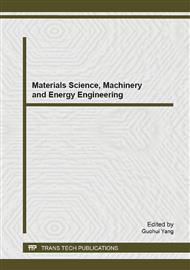[1]
S.Y. Lee, S.J. Kim, S.Y. Chung and C.H. Jeong: Sorption of hydrophobic organic compounds onto organoclays. Chemosphere, Vol. 55 (2004), pp.781-785.
DOI: 10.1016/j.chemosphere.2003.11.007
Google Scholar
[2]
E. Hynkova, Z. Cechova and G. Sadovska: Corrosion properties and composition of pore water from bentonites. Chem. Listy, Vol. 101 (2007), pp.415-421.
Google Scholar
[3]
W. Matthes and G. Kahr: Sorption of organic compounds by Al and Zr-hydroxy-intercalated and pillared bentonite. Clay Clay Min., Vol. 48 (2000), pp.593-602.
DOI: 10.1346/ccmn.2000.0480601
Google Scholar
[4]
S. Triantafyllou, E. Christodoulou and P. Neou-Syngouna: Removal of nickel and cobalt from aqueous solutions by Na-activated bentonite. Clay Clay Min., Vol. 47 (1999), pp.567-572.
DOI: 10.1346/ccmn.1999.0470503
Google Scholar
[5]
W. Matthes, F.W. Madsen and G. Kahr: Sorption of heavy-metal cations by Al and Zr-hydroxy-intercalated and pillared bentonite. Clay Clay Min., Vol. 47 (1999), pp.617-629.
DOI: 10.1346/ccmn.1999.0470508
Google Scholar
[6]
V. Stone, B. Nowack, A. Baun, N. Brink, F. Krammer, M. Dusinska, R. Handy, S. Hankin, M. Hassellov, E. Joner and T.F. Fernandes: Nanomaterials for environmental studies: Classification, reference material issues, and strategies for physico-chemical characterisation. Sci. Total Environ., Vol: 408 (2010).
DOI: 10.1016/j.scitotenv.2009.10.035
Google Scholar
[7]
P. Borm: The potential risks of nanomaterials: a rewiev carried out for ECETOC. Part. Fibre Toxicol. Vol. 3 (2006), pp.1-35.
Google Scholar
[8]
T. Sovova and V. Koci: Ecotoxicology of nanomaterials. Chem. Listy, Vol. 106 (2012), pp.82-87.
Google Scholar
[9]
R. Lopez-Roldan, L. Kazlauskaite, J. Ribo, M.C. Riva, S. Gonzales and J.L. Cortina: Evaluation of an automated luminescent bacteria assay for in situ aquatic toxicity determination. Sci. Total Environ., Vol. 440 (2012), pp.307-313.
DOI: 10.1016/j.scitotenv.2012.05.043
Google Scholar
[10]
A. Viani, A.F. Gaultieri and G. Artioli: The nature of disorder in montmorillonite by simulation of X-ray powder patterns. Am. Miner., Vol. 87 (2002), pp.966-975.
DOI: 10.2138/am-2002-0720
Google Scholar
[11]
P.R. Day, in: Methods of soil analysis, Patr 1, edited by C.A. Black, American Society of Agronomy, Inc., Madison, Wisconsin, pp.545-567 (1965).
Google Scholar
[12]
D.P. Franzmeier, G.C. Steinhardt, J.F. Crum and L.D. Norton: Soil Characterization in Indiana: I. Field and Laboratory Procedures. Research Bulletin No. 943, pp.13-14 (1977).
Google Scholar
[13]
R. Rojickova-Padrtova, B. Marsalek and I. Holoubek: Evaluation of alternative and standard toxicity assays for screening of environmental samples: Selection of an optimal test battery. Chemosphere, Vol. 37 (1998), pp.495-507.
DOI: 10.1016/s0045-6535(98)00065-4
Google Scholar
[14]
N. Strigul, L. Vaccari, C. Galdun, M. Wazne, X. Liu, C. Christodoulatos and K. Jasinkiewicz: Acute toxicity of boron, titanium dioxide, and aluminum nanoparticles to Daphnia magna and Vibrio fischeri. Desalination, Vol. 248 (2009), pp.771-782.
DOI: 10.1016/j.desal.2009.01.013
Google Scholar
[15]
J. Lappalainen, R. Juvonen, J. Nurmi and M. Karp: Automated color correction method for Vibrio fischeri toxicity test. Comaprision of standard and kinetic assays. Chemosphere, Vol. 45 (2001), pp.635-641.
DOI: 10.1016/s0045-6535(00)00579-8
Google Scholar


